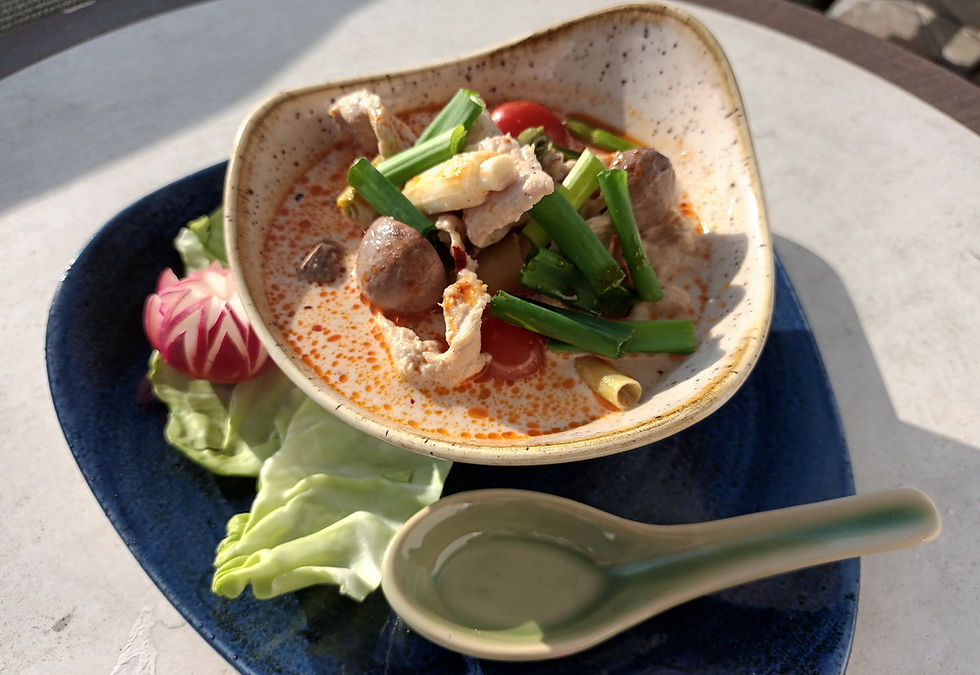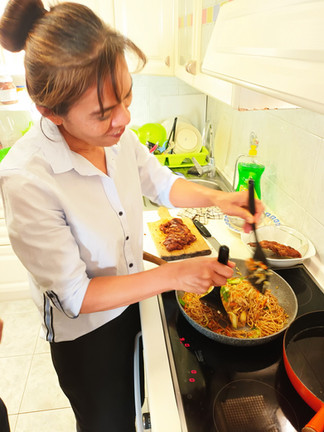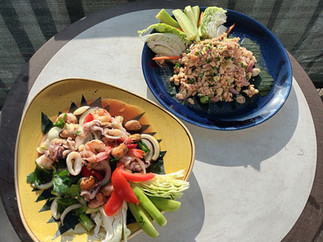Sabai - Tastes of Thailand in Rijeka
- Vedran Obućina
- Nov 14, 2021
- 6 min read
Directly translated into English, the word ‘sabai’ (สบาย) means comfortable. It is similar to the concept of ‘Gemütlichkeit’ in German, essentially a way of expressing feelings of general comfort or relaxation. In essence, this can be seen as a strong sense of peace. You could go on to say that ‘sabai sabai’ is a reflection of Thai culture, conveying this special feeling. So, the next time you sit on one of the amazing Thai island beaches, you will know how to describe the feeling you have. If you are not able to travel to Thailand, you can stop by the Sabai restaurant, a new place of Thai flavours in the heart of Rijeka!

Thailand is world-famous for its food, which is also the main trump card of Thai tourism with beautiful beaches and resorts. The author of this article spent several months in this Southeast Asian kingdom, getting to know all the flavours of a very diverse Thai cuisine. Coincidentally, before the opening of the Sabai restaurant, he found himself in the company of co-owners Marin Pavletić and Filip Jakovac and a master of Thai cuisine Somy. With a pleasant and diverse team, we review the menu and wonder what enthusiasm is behind this project.

"Everything in Sabai revolves around food and atmosphere. We wondered how something Thai could become indigenous to Rijeka. And we remembered: We live in a city that flows, accepts all faces and makes dreams come true. Thai is indigenous to Rijeka because in the city of everyone - every nation is indigenous. Thus, through a game of opportunity, a Thai family of professional and experienced chefs decided to choose Rijeka as their port. Well, to be realistic, they decided to do it with wholehearted help and some reassurance from our two locals, but about that later. To hear more visit us and discover why Sabai is a new place that celebrates not only the best food but also the best atmosphere. An atmosphere of sharing. Something like this has never happened before in our city, and even beyond... " Marin and Filip talk about this rather brave step, which will surely meet with the approval of fans of Asian food.

They will enjoy a variety of appetizers in Sabai, among which soups and salads predominate. Inevitably, Tom Yum Goong’s soup is on that list. This cult bowl of goodness steaming on every corner of Thailand is bold, aromatic and comes with a pretty strong spicy punch. Tom yum goong was created with key Thai ingredients such as lemongrass, chilli, galangal, kaffier lime leaves, shallots, fresh lime juice and lots of fish sauce. Add fresh shrimp and mushrooms and coconut cream if you want a creamy version. Tom kha gai is associated with this yum and offers people with lower tolerance to spices the opportunity to taste the same wonderful flavours. Aside from the spice scale, Tom kha gai is also unique in that it usually comes with lots of creamy coconut milk creating a rich sweet soup. Like most Thai foods, vegetarian options are easily adapted by replacing several ingredients.

“Thai cuisine dedicates time to detail and balance. It is a refined blend of vegetables, meat and spices. The vegetables are half-cooked and thus retain the most important nutritional properties, the meat is fantastically processed, and the play of spices gives everything an irresistible charm and original taste ", says Marin as he puts in front of us a whole range of freshly prepared appetizers. Som Tam, a papaya or korab salad, was also found there. Som Tam originates from Isaan in northeastern Thailand and is one of the most popular dishes in the country. Som tam comes in a variety of styles, however, the classic som tam consists of chopped green papaya, tomatoes, carrots, peanuts, dried shrimp, beans, palm sugar, tamarind pulp, fish sauce, lime juice, garlic and plenty of chilli. The ingredients are mixed with a pestle, which enhances the flavours into an even more beautiful dish. In addition, it is great to snack on Paw pia thawt, spring rolls with vegetables or Goong hom pha, spring rolls with shrimp.

We were especially impressed by the marinated chicken in pandan leaves (Gai haw bai toei). The chicken is marinated and wrapped in small rolls of pandan leaves, then dipped in soy sauce, oyster sauce or sweet and sour sauce. Satee gai, a marinated chicken that can be combined with cucumber sauce and peanut sauce, is also available on skewers. For proponents of stronger flavours, there is Yam talay. This mixed seafood salad is not only delicious but also an option for a healthy meal. Depending on where you are, this salad can have any combination of squid, shrimp, mussels or crabs. Tomatoes, onions and rice glass noodles are added to the seafood mixture.

The tastes are various, and in Sabai they say: "Thai cuisine has a pronounced character. In order to successfully bring it closer to our palates, you will be able to choose the spiciness or spiciness of your dish and play with flavours. Even when we pair them with the best beers, wines and other drinks ... Ahhh. We were told not to choose comfortable chairs for the next guests to come as soon as possible, but we don’t want you to leave. Thai cuisine is a cooking ceremony and therefore an enjoyment ceremony. Sit down, be the only one, drink, socialize and celebrate life! ”

The list of main dishes includes some of the most famous combinations of Thai flavours. These are mostly curries, but don’t be confused by a name that has an Indian undertone. Thailand has been under Chinese but also Indian influence for centuries and these curries are significantly different from the Indian ones. However, their common feature is the richness of spices. Originally from central Thailand, green curry (Kaeing khiao wan gai) is the spiciest of all, with a perfect balance of added coconut milk. Green curry is made from some of the most delicious ingredients, including fresh green chilli, ginger, eggplant and, of course, lots of coconut milk, and the meat base is chicken. Eat with lots of steamed rice to reduce spice levels.

It is certainly inevitable to have a Thai restaurant offering Pad Thai. No foreign dish can compare to the popular invention of noodles that Thailand has put on the culinary map. Although it prides itself as a national dish, Pad Thai is far from it, this dish is designed for the growing Thai tourism industry, but it is an extremely popular dish. Pad Thai’s cooking base is not an easy task; each ingredient must be carefully added to create a delicious dish. Pad Thai must also be prepared quickly to make it hot and tasty.

No taste is forgotten in the making of Thai food. Spicy, sour, sweet, salty and bitter flavours are almost guaranteed to appear in the most prominent dishes of Thailand. Red curry (Gaeng phed gai) is, despite the name associated with more spice, still less spicy. It consists of chicken, red curry paste, coconut milk, carrots, beans, broccoli, cauliflower, bamboo, mushrooms and fish sauce. Both green and red curry are popular all over Thailand, but many agree that neither can match the delicious massaman curry. Massaman curry paste, tender potatoes, onions and coconut milk are cooked to perfection. The sauce, after thickening, is poured over the rice. In the Sabai restaurant, you will be able to taste chicken (Massaman gai curry) and beef (Massaman nuea curry).

Kai med ma muang is loved by locals and foreigners alike. This sweet and delicious dish is fried chicken with cashews, soy sauce, honey, onions, chili, pepper, mushrooms, basically those vegetables that the chef has on hand. Simple, and very tasty. An additional exotic taste is given by Gai pad priew wan or chicken with a sour-hot sauce of tomatoes, peppers, onions, pineapples and spring onions. Not all of these ingredients come from a foreign country: “The speciality of our Thai cuisine is that we use fresh ingredients. Yes, believe it or not, but our exotic herbal friends come fresh to your plate, and the sauces ...? We don’t buy sauces. We make them with our own hands from fresh spices from an exotic Thai garden. You will realize that Sabai is no ordinary restaurant, Sabai is a family. A family ruled by a love of food and life. Give us a part of your love and become a part of our family ", the owners proudly tell us!

Perhaps the only departure from this rule is the delicious Chinese goose that comes right from China. Rice, too, is purchased through Asian stores that deliver rice of exceptional quality and wonderful smell and taste. This beautiful gesture of mostly domestic products is rounded off by some of the most typical Thai desserts. It is Kao niew ma muang is simple but extremely tasty, made from sticky rice, fresh slices of mango and sweet condensed milk.

We will come to Sabai often, especially since Thai food is as created for the city as a snack bar like Rijeka. It will be a place of exceptional moments, outdoor cuisine and a point of refined flavours on colourful plates that evoke pleasant moments of the Asian South. Until then, "sabai, sabai!"
Sabai Restaurant
Šime Ljubića 8a, 51000 Rijeka
































Comments